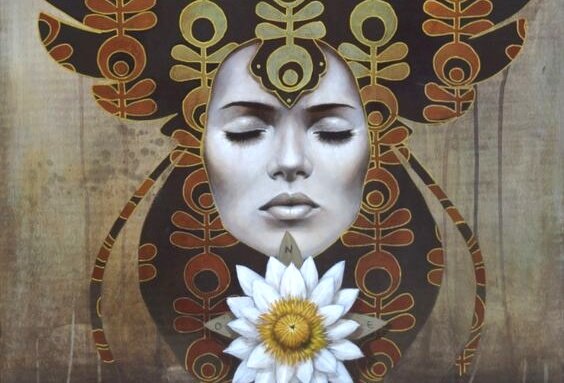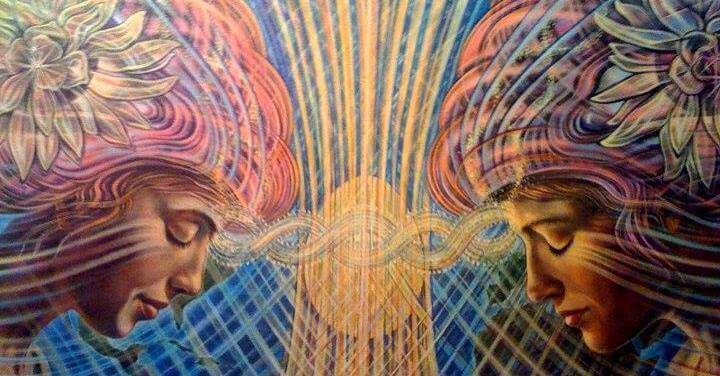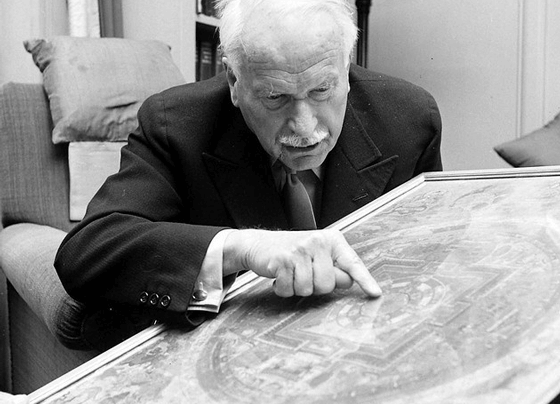Jung's Spiritual Awakening

The work of Carl Jung is a process of constant searching, a wonderful alchemy between Analytical Psychology, Anthropology and Philosophy which has given us such interesting concepts as “the collective unconscious”, “archetypes”, “synchronicity” and the foundation of a spiritual legacy where you can find a whole crucible of ideas. When we talk about famous psychologists, the first one that most people think of is the iconic Sigmund Freud. However, for many, it was Carl Gustav Jung who managed to leave a much deeper imprint in the study of the personality and the human psyche. And part of that was because of Jung’s spiritual awakening.
“If you are a talented person it does not mean that you have received something, it means that you can do something”
-Carl Gustav Jung-
It must be said that even though Jung worked closely with Sigmund Freud for years, the latter’s focus on sexuality as a relevant factor in human behavior was always a difficult pill to swallow for the Swiss psychiatrist.
In the extraordinary mind of this free thinker, the founder of Analytical Psychology, there were many more concerns that went beyond the theoretical fundamentals that Freud moved in. Despite being a practicing clinical psychologist, well versed in its theory too, he devoted most of his life to exploring other realms. He got wrapped up in Eastern and Western philosophy, arts, literature, astrology, sociology and even alchemy.
A legacy of fascinating knowledge and here’s how it all came about…

The childhood dream that opened his eyes
C. G Jung once said that human beings are born three times. The first is the real physical birth. The second occurs with the development of the ego, and the third is what leads to the birth of what he called “spiritual consciousness.” According to Jung, this last birth will never happen if the person focuses exclusively on the ego, on its conditioning and on our rigid unresponsive mental patterns.
“Dreams are the small door hidden in the deepest and most intimate sanctuary of the soul”
-Carl Gustav Jung-
It seems that Jung himself experienced this third awakening as a child thanks to a strange, symbolic and fascinating dream. In it was a large room with a red carpet with a strange being lying flat out on it. It was a tree-like monster that sported an immense eye in the middle of his forehead. It had the skin of a man and barely reacted when little Gustav Jung approached him. However, he was soon able to hear his mother’s voice shouting at him from a nearby grave, telling him not to approach the monster because it was “the eater of men“.

Although at first he took the dream to be more of a terrible nightmare, it soon awakened in him a deep interest in the world of the surreal and its symbolism. Years later he was aware that this dream was like a call, a direct invitation to investigate what psychoanalysts would later call “the unconscious“.
Jung’s Spiritual Awakening
Although the clinical approach that C. Gustav Jung worked with was based on a very theoretical psychiatry, it was always clear to him that he didn’t want to stay within that limited vision of human knowledge. He soon incorporated roots of anthropology, concepts of art and spirituality into his theories, as well as the cultural legacy which hid revealing ideas about the realm of the unconscious.
- Jung studied Christianity, Hinduism, Buddhism, Gnosticism, Taoism and other traditions in depth, because, for him, the spiritual life constituted the very root of psychic life.
- One of its backbones was that to understand the human mind we also have to study its products.
- In turn, he maintained on multiple occasions that all spiritual experiences were essential to promote our well-being, something which Sigmund Freud didn’t agree with.
- In 1944 Jung published “Psychology and Alchemy” to show how many hidden symbols used by alchemists are hidden in many of our most common dreams, as well as mythological images that are rooted in our subconscious.
With these ideas, Jung reinforced the universal character of his theory of the archetype, by also making a valuable defense of spirituality as a tool to improve the psychic health of modern man.

Jung and his study of mandalas
C. G Jung, in his infinite passion for knowledge rooted in our ancient cultures, didn’t take long to discover the psychological effects of the mandalas, while he was studying Eastern religion.
- As he explained on numerous occasions, the mandala corresponds to a sacred geometric design capable of provoking something positive as well as therapeutic in our inner being.
- Every figure with a circle shape is not only representative of the cosmos, it is also a direct invitation for us to listen to our being, to restore harmony and to favor growth and an awakening.
Jung used the mandalas with his patients to help them listen to their inner voice. It was a way to decentralize the ego, to break the murmuring of obsessive thoughts so that the person could find new routes of liberation and come to a new state of consciousness.
“What you deny submits to you, what you accept transforms you”
-Carl Gustav Jung-

To conclude, the legacy of Carl Gustav Jung is undoubtedly one of the most vast and richest in terms of knowledge, approaches and conceptions. Although his theoretical contributions are still very present in the field of psychoanalysis, to this day there are many who prefer to focus only on his spiritualist ideals.
We would like to invite you to get to know the full range of his work, missing none of it. Books like “The Red Book“, “Man and his symbols” or “Memories, dreams, thoughts” are testimonies of a multidisciplinary approach, a melting pot of knowledge and awakenings that today continue to inspire everyone, whether they be experts, laymen or simply inquisitive.
The work of Carl Jung is a process of constant searching, a wonderful alchemy between Analytical Psychology, Anthropology and Philosophy which has given us such interesting concepts as “the collective unconscious”, “archetypes”, “synchronicity” and the foundation of a spiritual legacy where you can find a whole crucible of ideas. When we talk about famous psychologists, the first one that most people think of is the iconic Sigmund Freud. However, for many, it was Carl Gustav Jung who managed to leave a much deeper imprint in the study of the personality and the human psyche. And part of that was because of Jung’s spiritual awakening.
“If you are a talented person it does not mean that you have received something, it means that you can do something”
-Carl Gustav Jung-
It must be said that even though Jung worked closely with Sigmund Freud for years, the latter’s focus on sexuality as a relevant factor in human behavior was always a difficult pill to swallow for the Swiss psychiatrist.
In the extraordinary mind of this free thinker, the founder of Analytical Psychology, there were many more concerns that went beyond the theoretical fundamentals that Freud moved in. Despite being a practicing clinical psychologist, well versed in its theory too, he devoted most of his life to exploring other realms. He got wrapped up in Eastern and Western philosophy, arts, literature, astrology, sociology and even alchemy.
A legacy of fascinating knowledge and here’s how it all came about…

The childhood dream that opened his eyes
C. G Jung once said that human beings are born three times. The first is the real physical birth. The second occurs with the development of the ego, and the third is what leads to the birth of what he called “spiritual consciousness.” According to Jung, this last birth will never happen if the person focuses exclusively on the ego, on its conditioning and on our rigid unresponsive mental patterns.
“Dreams are the small door hidden in the deepest and most intimate sanctuary of the soul”
-Carl Gustav Jung-
It seems that Jung himself experienced this third awakening as a child thanks to a strange, symbolic and fascinating dream. In it was a large room with a red carpet with a strange being lying flat out on it. It was a tree-like monster that sported an immense eye in the middle of his forehead. It had the skin of a man and barely reacted when little Gustav Jung approached him. However, he was soon able to hear his mother’s voice shouting at him from a nearby grave, telling him not to approach the monster because it was “the eater of men“.

Although at first he took the dream to be more of a terrible nightmare, it soon awakened in him a deep interest in the world of the surreal and its symbolism. Years later he was aware that this dream was like a call, a direct invitation to investigate what psychoanalysts would later call “the unconscious“.
Jung’s Spiritual Awakening
Although the clinical approach that C. Gustav Jung worked with was based on a very theoretical psychiatry, it was always clear to him that he didn’t want to stay within that limited vision of human knowledge. He soon incorporated roots of anthropology, concepts of art and spirituality into his theories, as well as the cultural legacy which hid revealing ideas about the realm of the unconscious.
- Jung studied Christianity, Hinduism, Buddhism, Gnosticism, Taoism and other traditions in depth, because, for him, the spiritual life constituted the very root of psychic life.
- One of its backbones was that to understand the human mind we also have to study its products.
- In turn, he maintained on multiple occasions that all spiritual experiences were essential to promote our well-being, something which Sigmund Freud didn’t agree with.
- In 1944 Jung published “Psychology and Alchemy” to show how many hidden symbols used by alchemists are hidden in many of our most common dreams, as well as mythological images that are rooted in our subconscious.
With these ideas, Jung reinforced the universal character of his theory of the archetype, by also making a valuable defense of spirituality as a tool to improve the psychic health of modern man.

Jung and his study of mandalas
C. G Jung, in his infinite passion for knowledge rooted in our ancient cultures, didn’t take long to discover the psychological effects of the mandalas, while he was studying Eastern religion.
- As he explained on numerous occasions, the mandala corresponds to a sacred geometric design capable of provoking something positive as well as therapeutic in our inner being.
- Every figure with a circle shape is not only representative of the cosmos, it is also a direct invitation for us to listen to our being, to restore harmony and to favor growth and an awakening.
Jung used the mandalas with his patients to help them listen to their inner voice. It was a way to decentralize the ego, to break the murmuring of obsessive thoughts so that the person could find new routes of liberation and come to a new state of consciousness.
“What you deny submits to you, what you accept transforms you”
-Carl Gustav Jung-

To conclude, the legacy of Carl Gustav Jung is undoubtedly one of the most vast and richest in terms of knowledge, approaches and conceptions. Although his theoretical contributions are still very present in the field of psychoanalysis, to this day there are many who prefer to focus only on his spiritualist ideals.
We would like to invite you to get to know the full range of his work, missing none of it. Books like “The Red Book“, “Man and his symbols” or “Memories, dreams, thoughts” are testimonies of a multidisciplinary approach, a melting pot of knowledge and awakenings that today continue to inspire everyone, whether they be experts, laymen or simply inquisitive.
This text is provided for informational purposes only and does not replace consultation with a professional. If in doubt, consult your specialist.







